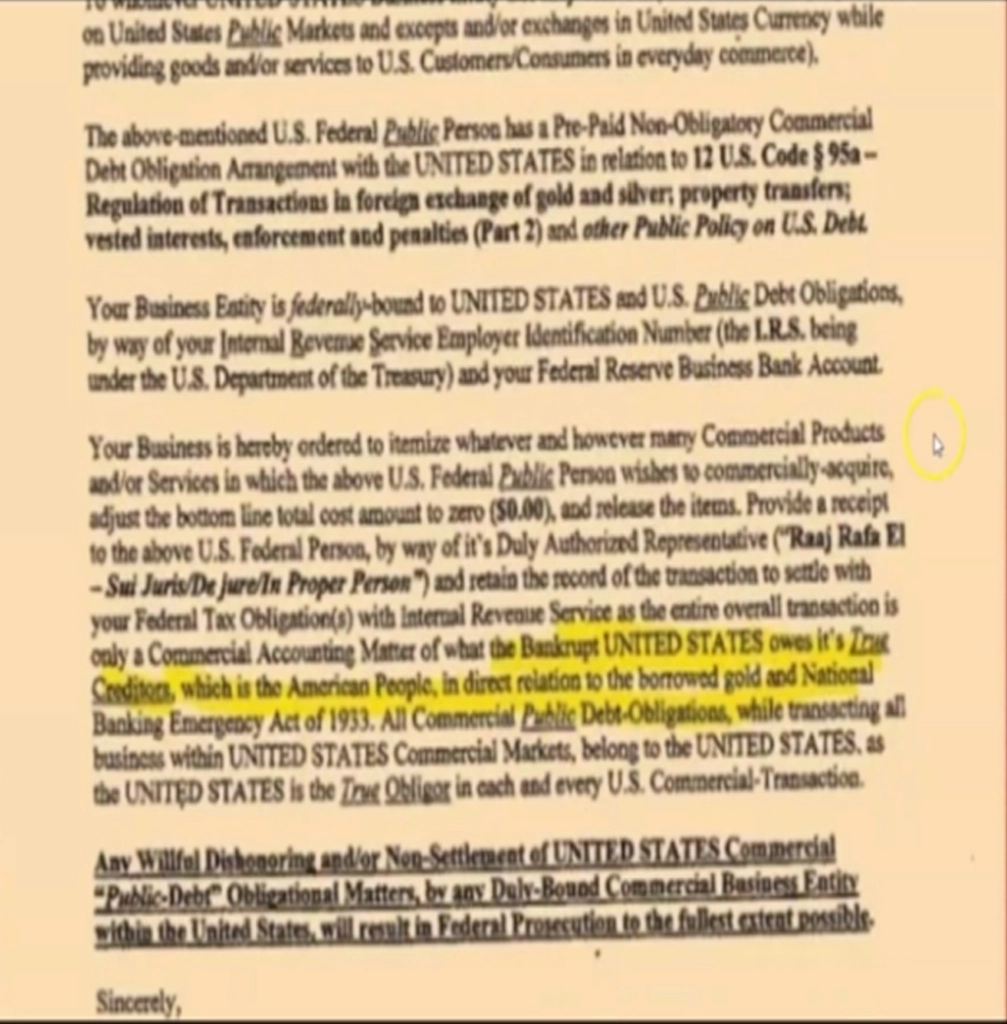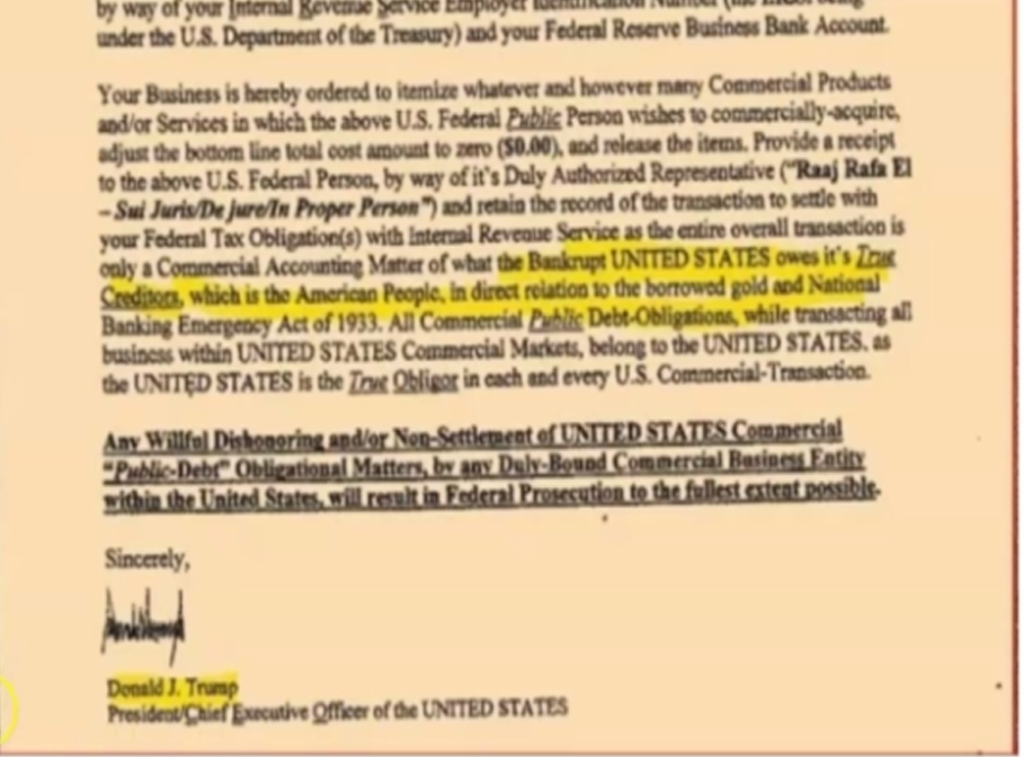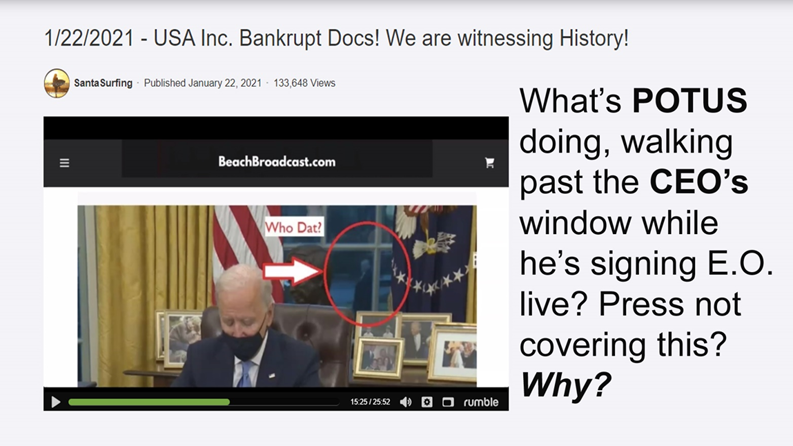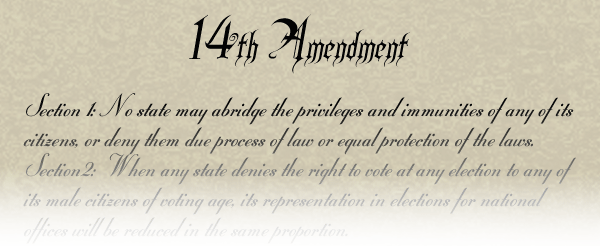USA INC. BANKRUPT – NO MORE IRS! WHERE’S POTUS?
This is fantastic news. It appears the citizens of the Republic of the United States of America, based on the Constitution and Bill of Rights, is no longer indebted to the service of the Corporation known as The UNITED STATES. And if so, we are no longer indebted to the taxation, any and all financial corporate agreements and demands, for on May 4, 2020, the UNITED STATES, INC. filed a Chapter 11 bankruptcy.
UPDATE CORRECTION: Santa Surfer has clarified her video information and the actual companies that went bankrupt, filed in Jacksonville Florida are in this link: Case number: 4:20-bk-40375 – United States Corporation Company – Florida Northern Bankruptcy Court (inforuptcy.com) Not to be confused with any USA Inc. Bankrupt Docs. The Marshall Report apologizes for any misunderstandings this information could have caused. Thank you.

Below I have written the words from this page out for you to read more clearly.
“The above mentioned U.S. Federal Public Person has a Pre- Paid Non-Obligatory Commercial Debt Obligation Arrangement with the UNITED STATES in relation to 12 U.S. Code §95a-Regulation of transactions in foreign exchange of gold and silver; property transfers; vested interests, enforcement and penalties (Part 2) and other Public Policy on U.S. Debt.
“Our Business Entity is federally-bound to United States and U.S. Public Debt. Obligations, by way of your Internal Revenue Service Employer Identification Number (the I.R.S. being under the U.S. Department of the Treasury) and your Federal Reserve Business Bank Account. Your Business is hereby ordered to itemize whatever and however many Commercial Products and/or Services in which the above U.S. Federal Public Person wishes to commercially acquire, adjust, the bottom line Total cost amount to zero ($0.00), and release the items. Provide a receipt to the above U.S. Federal Person, by way of its Duly Authorized Representative (”Raaj Rafa El-Sui Juris/DeJure/ In Proper Person”) and retain the record of the transaction to settle with your Federal Tax Obligations(s) with Internal Revenue Service as the entire overall transaction is only a Commercial Accounting Matter of what the Bankrupt UNITED STATES owes It’s True Credition, which is the American People, in direct relation to the borrowed gold and National Banking Emergency Act of 1933. All Commercial Public Debt-Obligations, while transacting all business within UNITED STATES Commercial Markets, belong to the UNITED STATES, as the UNITED STATES is the True Obligor in each and every U.S. Commercial-Transaction.
“Any Willful Dishonoring and/or Non-Settlement of UNITED STATES Commercial “Public-Debt” Obligational Matters, by any Duly-Bound Commercial Business Entity within the United States, will result in Federal Prosecution to the fullest extent possible.“

Each must do their own sleuthing and their own critical thinking…
I trust the research of those who discovered these official documents, and each can reason for themselves. Each person can and should do their own research. With a liar fake news, and a corrupt congressional body as a whole, We The People are left to do our own research and draw our own reasonable assumptions. It is up to each to find nuggets of truth and fit them together in order to present some sense out of all the chaos and confusion that has been created by those who over the lifetime of this nation have crept in little by little to usurp the land, and it’s people into their own web of tyranny. It has also been reported that many involved in the coup to overthrow the United States Government have already been arrested and more arrests are coming.
THE CEO Signed Executive Orders for a Bankrupt Corporation. How amazing that he had his E.O.’s ready to go and just imagine…if that stack of orders would have actually been legally implemented? I wonder how his impeachment will turn out? Remember, impeachment papers have been filed by Representative Greene.
Here is a larger picture of POTUS in the parking lot outside the window of the executive office of the CEO.
Now one would think that with all the press in the Oval Office they would have noticed POTUS walking past the window? They would have been all over this, ripping Trump apart to creating outrageous motives for him being on the White House grounds. They would have spinned some tale of Trump disrupting the newly appointed CEO and pushed out something absurd to secure the Pelosi/Schumer impeachment. But they did not. Why is that? And where is the information on why there is now a parking lot in the front of the oval office?
More interesting is why the national guards stationed at the event, did not hear any songs, music, speeches, or see any of the pomp we are told took place on the day of the inaugural event in D.C.? And why did no Marines salute the new CEO in the film of him entering the White House? We know the CEO did not salute, but he did say to salute the officers. Why did the CEO have to charter his own private plane to his inaugural? If it all looks strange, it is because it is strange.
The entire coverage is full of clues. This is a live board game of Clue! Who did it and where? Enjoy the show and now that you know what to look for… start looking!
God Bless and hold the line. Pray for a smooth transition. There will be some rough spots for wild beasts are not easily captured and definately not tamed.
Dianne Marshall
124 thoughts on “USA INC. BANKRUPT – NO MORE IRS! WHERE’S POTUS?”
District of Columbia Organic Act of 1871
History[edit]
The passage of the Residence Act in 1790 created a new federal district that would become the capital of the United States. Formed from land donated by the states of Maryland and Virginia, the capital territory already included two large settlements at its creation: the port of Georgetown, Maryland and the town of Alexandria, Virginia. A new capital city named in honor of President George Washington was founded to the east of Georgetown in 1791.
Shortly after establishing operations in the new capital, Congress passed the Organic Act of 1801, which organized the federal territory. The territory within the federal district east of the Potomac formed the new County of Washington, which was governed by a levy court consisting of seven to eleven Justices of the Peace appointed by the President, and was governed by Maryland law as of 1801. The area west of the river became Alexandria County which was governed by Virginia law. In addition, Congress allowed the cities of Washington, Alexandria and Georgetown to each maintain their own municipal governments. In 1846 Alexandria County was returned by Congress to the state of Virginia.
The outbreak of the American Civil War in 1861 led to notable growth in the capital's population due to the expansion of the federal government and a large influx of emancipated slaves.[2] By 1870, the District's population had grown 75% to nearly 132,000 residents.[3] Growth was even more dramatic within the County of Washington, where the population more than doubled as people escaped the crowded city.[4]
The individual local governments within the District were insufficient to handle the population growth. Living conditions were poor throughout the capital, which still had dirt roads and lacked basic sanitation. The situation was so bad that some lawmakers in Congress even suggested moving the capital out further west, but President Ulysses S. Grant refused to consider the proposals.[5]
Effect[edit]
Instead, Congress passed the Organic Act of 1871, which revoked the individual charters of the cities of Washington and Georgetown and combined them with Washington County to create a unified territorial government for the entire District of Columbia.[6] The new government consisted of an appointed governor and 11-member council, a locally elected 22-member assembly, and a board of public works charged with modernizing the city.[7] The Seal of the District of Columbia features the date 1871, recognizing the year the District's government was incorporated.[8]
The Act did not establish a new city or city government within the District. Regarding a city of Washington, it stated that "that portion of said District included within the present limits of the city of Washington shall continue to be known as the city of Washington".[7] In the present day, the name "Washington" is commonly used to refer to the entire District, but DC law continues to use the definition of the city of Washington as given in the Organic Act.[9]
In 1873, President Grant appointed an influential member of the board of public works, Alexander Robey Shepherd, to the post of governor. Shepherd authorized large-scale municipal projects, which greatly modernized Washington. In doing so however, the governor spent three times the money that had been budgeted for capital improvements, bankrupting the city.[10] In 1874, Congress replaced the District's quasi-elected territorial government with an appointed three-member Board of Commissioners. Direct rule by Congress continued until the passage of the District of Columbia Home Rule Act in 1973.[11]
Conspiracy theories[edit]
The Act served as the basis of conspiracy theories relating to the sovereign citizen movement. According to these, the Act would have made the District, and consequently the whole United States, into a corporation.[12] There is no evidence for these claims, which stem from a misinterpretation of the meaning of the term municipal corporation used in the Act.[13][14] The vocabulary used has in fact a wider meaning here, and refers to any group authorized to act as a single entity (in this case, an incorporated, organized district of the United States).
Recently, these conspiracy theories have been tied to the larger QAnon movement.[14][15]















[…] https://themarshallreport.wordpress.com/2021/01/24/usa-inc-bankrupt-no-more-irs-wheres-potus/amp/ […]
Like
Interesting article!!! Could you please provide me with the link to the bankruptcy filing in Florida so I can read in full entirety, as I have been looking for this for quite some time now. You can send info to:
ddumas29@yahoo.com it would be very much appreciated!
Like